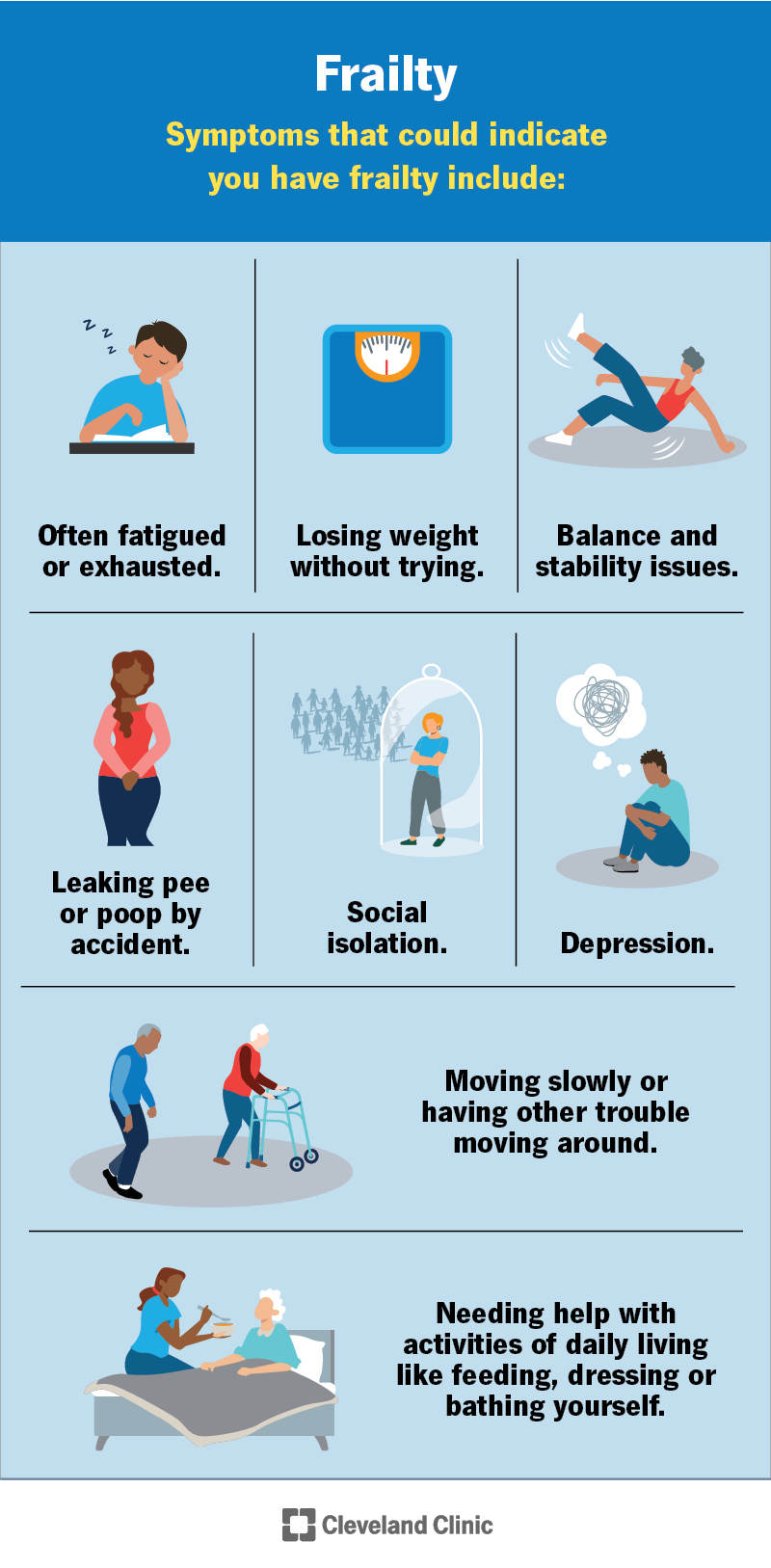Frailty might be the same as weakness in the dictionary, but it isn’t the same in the medical world. The medical definition of frailty revolves around your body being unable to handle more strain from illnesses or injuries. Giving your body time to recuperate and making recovery easier are essential to treating and even reversing this issue.
Advertisement
Cleveland Clinic is a non-profit academic medical center. Advertising on our site helps support our mission. We do not endorse non-Cleveland Clinic products or services. Policy
Frailty is when your body can’t get through and recover from illnesses and injuries on its own. Your body is more vulnerable with frailty, making it harder to recover from health issues. As it worsens, frailty can disable you. It can keep you from doing day-to-day tasks that are part of being self-sufficient. It can also shorten your life expectancy. Frailty is sometimes reversible, but that varies from case to case.
Advertisement
Cleveland Clinic is a non-profit academic medical center. Advertising on our site helps support our mission. We do not endorse non-Cleveland Clinic products or services. Policy
Frailty and physical weakness aren’t the same thing. With frailty, your endurance, mental health and brain function also play a role. Frailty is like a spectrum, ranging from least severe to most. And frailty can happen to anyone, not just adults over 65.

There are many possible symptoms you can experience with frailty, including:
Frailty happens when your body isn’t healthy enough to recover from injuries or illnesses. This can happen over time if you have chronic medical conditions, take certain medications, have a limited diet and aren’t physically active.
Your health is like a bank account. It covers the cost of everything you do. That includes simple actions like breathing and blinking your eyes, or complex actions like bathing yourself. It also includes your body’s ability to endure and recover from illnesses and injuries. The bigger your balance, the farther from frailty you are.
Advertisement
You develop frailty if your health can’t cover the costs of everyday life. When that happens, it’s like you overdraw your account and need outside support just to keep your body running.
The things that help improve or maintain your health are like deposits into your bank account. They can help prevent frailty. These include:
But there are also things that reduce your health like withdrawals on your bank account. Things that can contribute to frailty include:
The more chronic (long-term) conditions you have, the easier it is to develop frailty. Things that can contribute to or make frailty worse include issues with your:
Research links the following with a higher risk of developing frailty:
Advertisement
Frailty can lead to the following complications:
A healthcare provider can diagnose frailty using a combination of methods. That includes a physical exam and using frailty scales or scoring systems. These scales or systems help your provider determine if you have frailty and how severe it is.
There are more than a dozen scales and scoring systems in common use around the world. And there’s no consensus on one being any better than the rest. Five of the most common criteria found on those scales and scoring systems include:
Advertisement
Experts often use measures of physical strength — like how strong your grip is — to determine if you have frailty. That’s a key reason behind the common misconception that frailty is the same as having physical weakness.
The scales and how they use the criteria vary. Some scales use criteria that relate to your mental functioning, incontinence, whether you have a support network and other factors.
Other tests might be possible, depending on your needs. Examples include a body mass index (BMI) measurement to check for muscle loss or undergoing a fall risk assessment. Your provider can tell you more about the tests they recommend.
Frailty can be managed — and sometimes reversed — with treatment and support. Some of the most common ways to do that include:
Advertisement
Depending on your specific circumstances and needs, other treatments are possible. Your healthcare provider can tell you about other treatment options.
The outlook for frailty depends on how severe it is and whether it’s possible to reverse it. When you can reverse frailty, the outlook is better. When it isn’t reversible, slowing down frailty or keeping it from getting worse are the next best options. Frailty is unique from one person to the next, so your healthcare provider is the best person to tell you the outlook for your case.
Frailty isn’t 100% preventable, but there are ways to reduce your risk of developing it. This usually involves keeping you as healthy as possible and managing or avoiding issues that make developing frailty more likely. Steps you can take include:
These steps are also important if you live with frailty. They can slow its progress and may even reverse it. There may be other ways you can prevent frailty, depending on your specific life circumstances, needs and preferences. A primary care provider can offer guidance and ideas on other steps you can take.
Frailty isn’t just about physical weakness. It’s your body’s way of signaling that it can’t handle the strain it’s under. While frailty is most common in people over 65, it isn’t inevitable. It's never too early to take steps to prevent or delay it. And if you have frailty now, that doesn’t mean you have to deal with it forever. Supportive treatments and medical care may help reverse or slow frailty down. And even in cases where that isn’t possible, there are ways to try to keep your quality of life high for as long as possible.
Cleveland Clinic’s primary care providers offer lifelong medical care. From sinus infections and high blood pressure to preventive screening, we’re here for you.

Last reviewed on 08/23/2024.
Learn more about the Health Library and our editorial process.